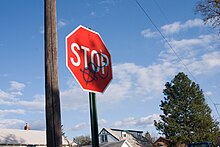
Graffiti are writing or drawings scribbled, scratched, or sprayed illicitly on a wall or other surface in a public place.[1] Graffiti ranges from simple written words to elaborate wall paintings. Graffiti, consisting of the defacement of public spaces and buildings, remains a nuisance issue for cities.
In America, graffiti was used as a form of expression by political activists, and also by gangs such as the Savage Skulls, La Familia, and Savage Nomads to mark territory. In 1969, Herbert R. Kohl published an article titled "Names, Graffiti and Culture" in The Urban Review describing how New York youth tagged their neighborhoods with their names and street numbers going back to the early 1960s.[2] Towards the end of the 1960s, the signatures—tags—of Philadelphia graffitists Cornbread, Cool Earl, and Sketch started to appear.[3][4] By the early 1970s, the New York City subway was the center for various types of innovative graffiti. Bubble lettering held sway initially among graffitists from the Bronx, though the elaborate writing Tracy 168 dubbed "wildstyle" would come to define the art.[3][5] The early trendsetters were joined in the 70s by graffitists like Dondi, Zephyr and Lady Pink.[3]
Graffiti is one of the four main elements of hip hop culture (along with rapping, DJing, and break dancing).[6] The relationship between graffiti and hip hop culture arises both from early graffitists practicing other aspects of hip-hop, and its being practiced in areas where other elements of hip hop were evolving as art forms. By the mid-eighties, the form would move from the street to the art world. Jean-Michel Basquiat would abandon his SAMO tag for art galleries, and street art's connections to hip-hop would loosen. Occasional hip hop paeans to graffiti could still be heard throughout the nineties, however, in tracks like the Artifacts' "Wrong Side of Da Tracks", Qwel's "Brick Walls" and Aesop Rock's "No Jumper Cables".[3]
- ^ "Graffiti". Oxford Dictionaries. Archived from the original on December 19, 2010. Retrieved December 5, 2011.
- ^ Kohl, Herbert R. (April 1969). "'Names, Graffiti and Culture'". The Urban Review. 3 (5): 24–38. doi:10.1007/BF02322246. S2CID 144104767. Retrieved May 28, 2023.
- ^ a b c d Peter Shapiro, Rough Guide to Hip-Hop, 2nd. ed., London: Rough Guides, 2007.
- ^ "A History of Graffiti in Its Own Words". New York.
- ^ David Toop, Rap Attack, 3rd ed., London: Serpent's Tail, 2000.
- ^ Hager, Steven. Hip Hop: The Illustrated History of Break Dancing, Rap Music, and Graffiti. St Martin's Press, 1984 (out of print).